This article was published as a part of the Data Science Blogathon
Exploratory data analysis is the first and most important phase in any data analysis. EDA is a method or philosophy that aims to uncover the most important and frequently overlooked patterns in a data set. We examine the data and attempt to formulate a hypothesis. Statisticians use it to get a bird eyes view of data and try to make sense of it.
In this EDA series we will cover the following points:
1. Data sourcing
2. Data cleaning
3. Univariate analysis
4. Bi-variate/Multivariate analysis
In this tutorial, we will cover the following topics with Examples using Python.
In this tutorial, we use the Kaggle Loan dataset.
So, Ready to explore EDA(Exploratory Data Analysis),..?
Let’s go… Let’s go… Let’s go
Data mainly arrives from a variety of sources, and your first responsibility as an analyst is to collect it. Because if you know your data batter then it’s easy to use for further analysis. So, collect the required data.
For research reasons, a substantial amount of data collected by the government or other public entities is made available. These data sets are referred to as public data because they do not require specific permission to view. On the internet, public data is available on a variety of platforms. A large number of data sets are available for direct analysis, while others must be manually extracted and translated into an analysis-ready format.
Data that is sensitive to organizations and consequently not available in the public domain is referred to as private data. Banking, telecommunications, retail, and the media are just a few of the major commercial sectors that significantly rely on data to make judgments. Many businesses are looking to use data analytics to help them make important choices. As businesses become more customer-centric, they may use data insights to improve the customer experience while also streamlining their daily operations.
Implementation:
import numpy as np
import pandas as pd
import matplotlib.pyplot as plt
%matplotlib inline
from scipy import stats
import re
import seaborn as sns
print('seaborn versiont:',sns.__version__)
import os
import warnings
warnings.filterwarnings('ignore') # if there are any warning due to version mismatch, it will be ignored
So now we ready to load the data set in Data Frame. here we go.,
loan = pd.read_csv('loan.csv',dtype='object')
loan.head(2)
In the above output, you can see we have many rows (but we print only two rows) and 111 columns.
Now we check Columns List & NA value counts more than 30%
NA_col = loan.isnull().sum()
NA_col = NA_col[NA_col.values >(0.2*len(loan))]
plt.figure(figsize=(20,4))
NA_col.plot(kind='bar')
plt.title('Columns List & NA value counts more than 30%')
plt.show()
Hit Run to see the output
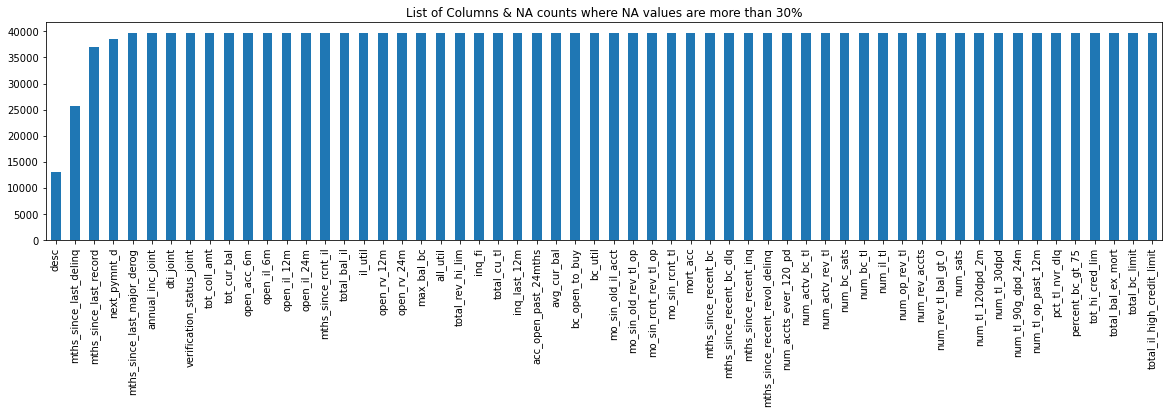
NA_col[NA_col.values >(0.2*len(loan))]
loan.isnull().sum()/len(loan)*100
loan.isnull().sum()
Insights Note: Here we clearly see that from the above plot we have 20+ columns in the dataset where all the values are NA.
Because the dataset has 887379 rows and 74 columns, it will be quite tough to go through each column one by one and discover the NA or missing values. So, let’s look for any columns that have more than a specific percentage of missing values, say 30%. We’ll get rid of such columns because it’s impossible to impute missing values for them.
When it comes to data, there are many different sorts of quality issues, which is why data cleansing is one of the most time-consuming aspects of data analysis.
Formatting issues (e.g., rows and columns merged), missing data, duplicated rows, spelling discrepancies, and so on could all be present. These difficulties could make data analysis difficult, resulting in inaccuracies or inappropriate results. As a result, these issues must be addressed before data can be analyzed. Data cleansing is frequently done in an unplanned, difficult-to-define manner. ‘single structured process’.
In the next steps, we’ll look at data cleaning:
– Invalid values might appear in numerous forms in a data set.
– Some inaccurate values, on the other hand, can be fixed.
** Some points on how to deal with invalid values **
Tips 1: Unicode should be encoded correctly:
Tips 2: Convert data types that aren’t correct:
Tips 3: Values that are out of range should be corrected as follows:
Tips 4: correct values that aren’t on the list include:
Tips 5: Correct any errors in the structure:
Tips 6: Internal rules must be verified:
>>> Find Check List excel workbook on my GitHub Data_Cleaning _Check_List.xlsx
Implementation:
Data Cleaning function for handling nulls and remove Nulls
def removeNulls(dataframe, axis =1, percent=0.3):
df = dataframe.copy()
ishape = df.shape
if axis == 0:
rownames = df.transpose().isnull().sum()
rownames = list(rownames[rownames.values > percent*len(df)].index)
df.drop(df.index[rownames],inplace=True)
print("nNumber of Rows droppedt: ",len(rownames))
else:
colnames = (df.isnull().sum()/len(df))
colnames = list(colnames[colnames.values>=percent].index)
df.drop(labels = colnames,axis =1,inplace=True)
print("Number of Columns droppedt: ",len(colnames))
print("nOld dataset rows,columns",ishape,"nNew dataset rows,columns",df.shape)
return df
1. Remove columns where NA values are more than or equal to 30%
loan = removeNulls(loan, axis =1,percent = 0.3)
2. Remove any rows with NA values greater than or equal to 30%.
loan = removeNulls(loan, axis =1,percent = 0.3)
3. Remove all columns with only one unique value.
unique = loan.nunique() unique = unique[unique.values == 1]
loan.drop(labels = list(unique.index), axis =1, inplace=True)
print("So now we are left with",loan.shape ,"rows & columns.")
4. Employment Term: Replace the value of ‘n/a’ with self-employed.’
There are some values in emp_term which are ‘n/a’, we assume that are ‘self-employed’. Because for ‘self-employed’ applicants, emp_length is ‘Not Applicable’
print(loan.emp_length.unique())
loan.emp_length.fillna('0',inplace=True)
loan.emp_length.replace(['n/a'],'Self-Employed',inplace=True)
print(loan.emp_length.unique())
print(loan.emp_length.unique())
print(loan.zip_code.unique())
5. Remove any columns that aren’t relevant.
Till now we have removed the columns based on the count & statistics. Now let’s look at each column from a business perspective if that is required or not for our analysis such as Unique IDs, URLs. As the last 2 digits of the zip code are masked ‘xx’, we can remove that.
not_required_columns = ["id","member_id","url","zip_code"]
loan.drop(labels = not_required_columns, axis =1, inplace=True)
print("So now we are left with",loan.shape ,"rows & columns.")
6. Convert all continuous variables to numeric values.
Cast all continuous variables to numeric so that we can find a correlation between them
numeric_columns = ['loan_amnt','funded_amnt','funded_amnt_inv','installment','int_rate','annual_inc','dti'] loan[numeric_columns] = loan[numeric_columns].apply(pd.to_numeric)
loan[numeric_columns] = loan[numeric_columns].apply(pd.to_numeric)
# loan rate has diff issue with % loan.int_rate.unique() loan['int_rate']=(pd.to_numeric(loan['int_rate'].str.replace(r'%', ''))) loan.int_rate loan['int_rate_bkp']=loan['int_rate']
7. Loan purpose: Remove records with values less than 0.75%.
We will analyze only those categories which contain more than 0.75% of records. Also, we are not aware of what comes under ‘Other’ we will remove this category as well.
(loan.purpose.value_counts()*100)/len(loan)
loan.purpose.value_counts()
del_loan_purpose = (loan.purpose.value_counts()*100)/len(loan)
del_loan_purpose = del_loan_purpose[(del_loan_purpose < 0.75) | (del_loan_purpose.index == 'other')]
loan.drop(labels = loan[loan.purpose.isin(del_loan_purpose.index)].index, inplace=True)
print("So now we are left with",loan.shape ,"rows & columns.")
print(loan.purpose.unique())
8. Loan Status: Remove all records with a value of less than 1.5%.
As we can see, Other than [‘Current’, ‘Fully Paid’ & Charged off] other loan_status are not relevant for our analysis.
(loan.loan_status.value_counts()*100)/len(loan)
del_loan_status = (loan.loan_status.value_counts()*100)/len(loan)
del_loan_status = del_loan_status[(del_loan_status < 1.5)]
loan.drop(labels = loan[loan.loan_status.isin(del_loan_status.index)].index, inplace=True)
print("So now we are left with",loan.shape ,"rows & columns.")
print(loan.loan_status.unique())
(loan.loan_status.value_counts()*100)/len(loan)
This session focuses on analyzing variables one at a time, as the term “uni-variate” implies. Before analyzing numerous variables together, it’s critical to first analyze each one individually.
When dealing with continuous variables, it’s important to know the variable’s central tendency and spread. Statistical metrics visualization methods such as Box-plot, Histogram/Distribution Plot, Violin Plot, and others are used to measure these.
We’ll utilize a frequency table to study the distribution of categorical variables. Count and Count percent against each category are two metrics that can be used to assess it. As a visualization, a count-plot or a bar chart can be employed.
Implementation:
The univariate function will plot parameter values in graphs.
def univariate(df,col,vartype,hue =None):
'''
Univariate function will plot parameter values in graphs.
df : dataframe name
col : Column name
vartype : variable type : continuous or categorical
Continuous(0) : Distribution, Violin & Boxplot will be plotted.
Categorical(1) : Countplot will be plotted.
hue : Only applicable in categorical analysis.
'''
sns.set(style="darkgrid")
if vartype == 0:
fig, ax=plt.subplots(nrows =1,ncols=3,figsize=(20,8))
ax[0].set_title("Distribution Plot")
sns.distplot(df[col],ax=ax[0])
ax[1].set_title("Violin Plot")
sns.violinplot(data =df, x=col,ax=ax[1], inner="quartile")
ax[2].set_title("Box Plot")
sns.boxplot(data =df, x=col,ax=ax[2],orient='v')
if vartype == 1:
temp = pd.Series(data = hue)
fig, ax = plt.subplots()
width = len(df[col].unique()) + 6 + 4*len(temp.unique())
fig.set_size_inches(width , 7)
ax = sns.countplot(data = df, x= col, order=df[col].value_counts().index,hue = hue)
if len(temp.unique()) > 0:
for p in ax.patches:
ax.annotate('{:1.1f}%'.format((p.get_height()*100)/float(len(loan))), (p.get_x()+0.05, p.get_height()+20))
else:
for p in ax.patches:
ax.annotate(p.get_height(), (p.get_x()+0.32, p.get_height()+20))
del temp
else:
exit
plt.show()
Continuous Variables
Let’s get some insights from loan data
1). Loan Amount
univariate(df=loan,col='loan_amnt',vartype=0)
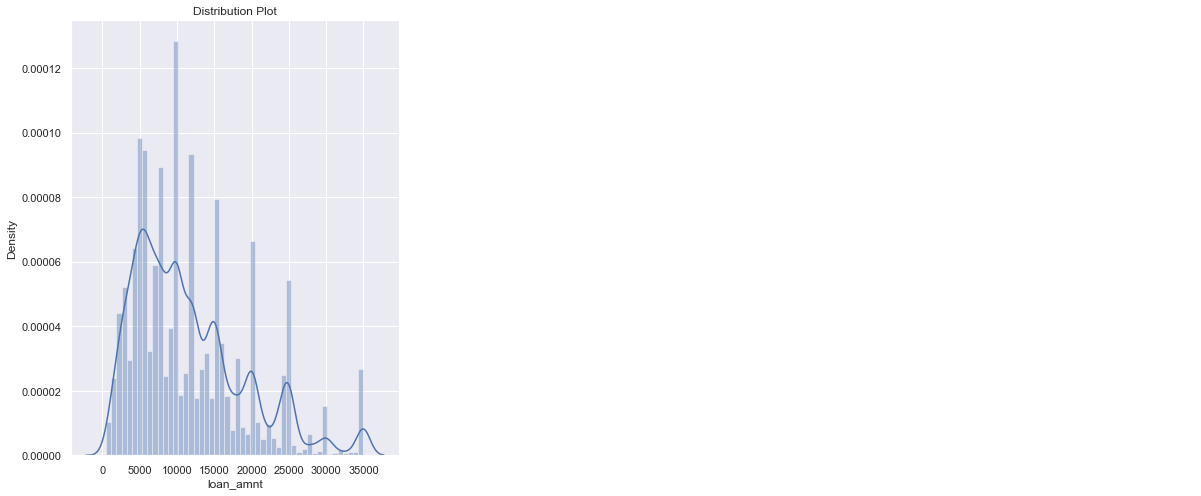
Insights: The majority of the loans range from 8000 to 20000 dollars.
loan['int_rate'] = loan['int_rate'].replace("%","", regex=True).astype(float)
univariate(df=loan,col='int_rate',vartype=0)
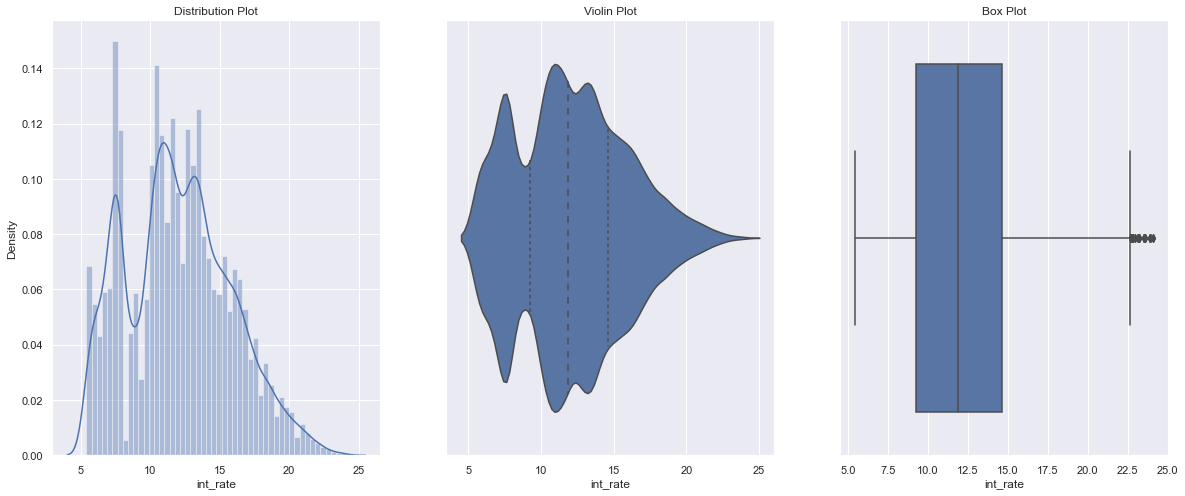
Insights: The majority of the loan interest rates are distributed between 10% to 16%.
3). Annual Income
loan["annual_inc"].describe()
Remove Outliers (values from 99 to 100%)
q = loan["annual_inc"].apply(lambda x: float(x)).quantile(0.995) loan = loan[loan["annual_inc"].apply(lambda x: float(x)) < q] loan["annual_inc"].describe()
loan['annual_inc'] = loan['annual_inc'].apply(lambda x: float(x)) univariate(df=loan,col='annual_inc',vartype=0)
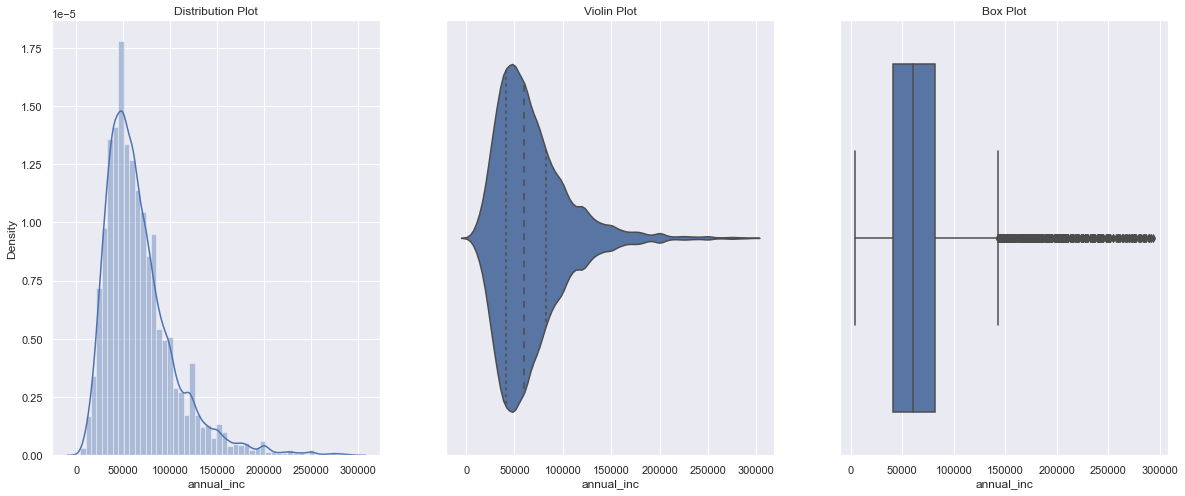
Insights: The majority of the loan applicants earn between 40000 to 90000 USD annually.
Categorical Variables
4). Loan Status
univariate(df=loan,col='loan_status',vartype=1)
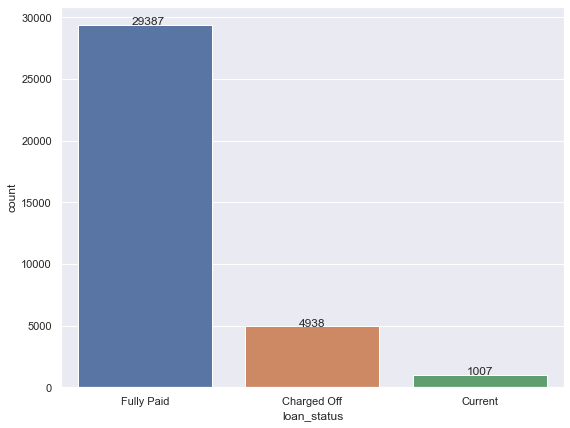
Insights: 5 % Charged off
5). Home Ownership Wise Loan
loan.purpose.unique()
loan.home_ownership.unique()
# Remove rows where home_ownership’==’OTHER’, ‘NONE’, ‘ANY’
rem = ['OTHER', 'NONE', 'ANY'] loan.drop(loan[loan['home_ownership'].isin(rem)].index,inplace=True) loan.home_ownership.unique()
univariate(df=loan,col='home_ownership',vartype=1,hue='loan_status')
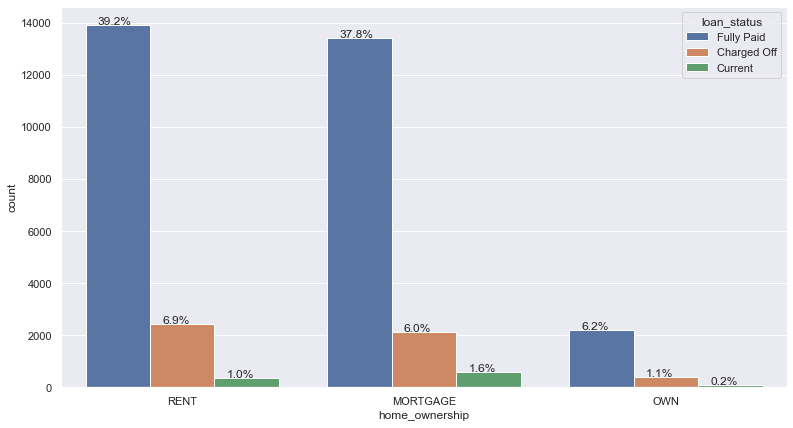
Insights: 40% of applicants live in a rented house, whereas 52% of applicants have a mortgage on their property.
The association between two/two or more variables is found using bivariate/multivariate analysis. For every combination of categorical and continuous data, we can perform Bi-variate/Multivariate analysis. Categorical & Categorical, Categorical & Continuous, and Continuous & Continuous are examples of possible combinations.
Purpose of Loan / Loan Amount for loan status
plt.figure(figsize=(16,12))
loan['loan_amnt'] = loan['loan_amnt'].astype('float')
sns.boxplot(data =loan, x='purpose', y='loan_amnt', hue ='loan_status')
plt.title('Purpose of Loan vs Loan Amount')
plt.show()
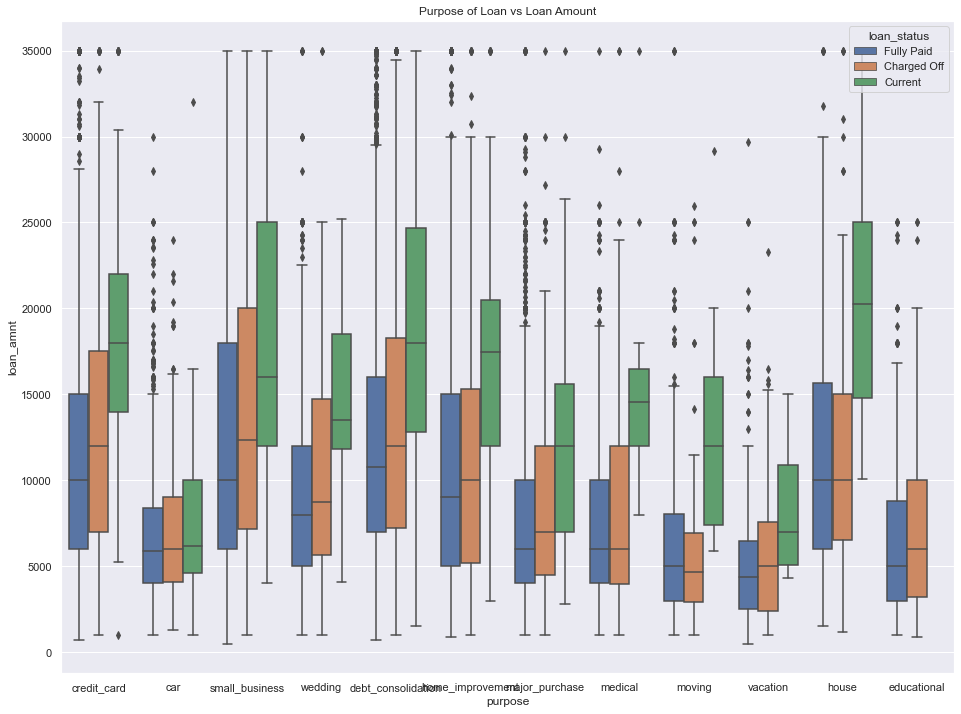
Heat Map for continuous variables
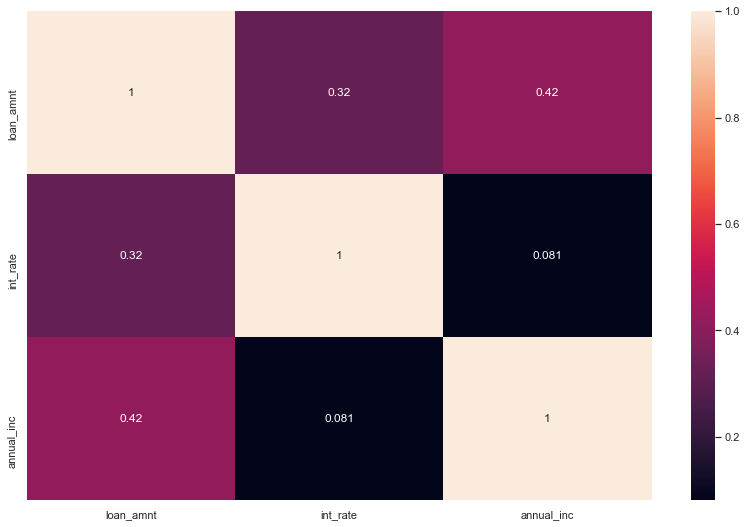
Insights: The Heat map clearly shows how closely ‘loan amount,’ funded amount, and funded amount inc’ are related. As a result, we can use any one of them for our analysis.
So, here we can see this all different aspect to consider Target Variable is Loan Status And top 5 major variables to consider for loan prediction: Purpose of Loan, Employment Length, Grade, Interest Rate, Term. Now we are ready to Train our model and prediction.
In this article, we learned the most important subjects for any type of analysis so far in this module. The following are the details:
Getting to know the domain Getting to know the data and prepare it for analysis
Univariate and segmented uni-variate analysis are two types of univariate analysis.
The bi-variate analysis is a technique for analyzing two variables at the same time.
Creating new metrics based on existing data
Thank you for reading!
I hope you enjoyed the article and increased your knowledge.
Please feel free to contact me on Email
Something not mentioned or want to share your thoughts? Feel free to comment below And I’ll get back to you.
Hardikkumar M. Dhaduk
Data Analyst | Digital Data Analysis Specialist | Data Science Learner
Connect with me on Linkedin
Connect with me on Github
The media shown in this article are not owned by Analytics Vidhya and are used at the Author’s discretion.
Lorem ipsum dolor sit amet, consectetur adipiscing elit,